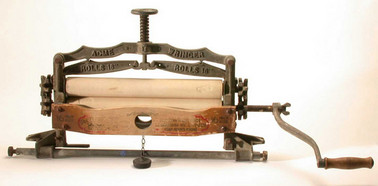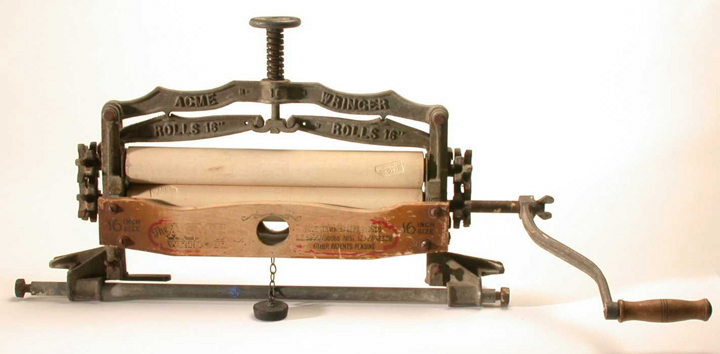Clothes Wringer, Victorian, Original
Laundry used to be very hard, physically tiring work. During the Victorian period, some devices were invented to ease household tasks. Small, domestic wringers and mangles were developed in the middle of the 19th century and soon became very popular. Before this, only laundry services or large houses with special laundry facilities used them. The rollers were made out of wood, usually beech or maple, but by the beginning of the 20th century rubber rollers were introduced.
The purpose of a wringer was to remove excess water from wet laundry. It also presses the clothes flat. The heavy frame of this wringer is made of cast iron. It is designed to be attached to a sink or a tub, probably one made specifically for this design. The ironwork of this item is stamped with ACME WRINGER ROLLS 16"". On the wooden panels it reads ""The Acme Wringer British made"". The 16"" (i.e. 16 inches) refers to the width of the rollers, which are made out of rubber. On top of the ringer there is a screw mechanism for adjusting the pressure of the rollers. The combination of the handle and a set of cogs turns the rollers.
The purpose of a wringer was to remove excess water from wet laundry. It also presses the clothes flat. The heavy frame of this wringer is made of cast iron. It is designed to be attached to a sink or a tub, probably one made specifically for this design. The ironwork of this item is stamped with ACME WRINGER ROLLS 16"". On the wooden panels it reads ""The Acme Wringer British made"". The 16"" (i.e. 16 inches) refers to the width of the rollers, which are made out of rubber. On top of the ringer there is a screw mechanism for adjusting the pressure of the rollers. The combination of the handle and a set of cogs turns the rollers.

Height:38.5cm

Height:38.5cm

Laundry used to be very hard, physically tiring work. During the Victorian period, some devices were invented to ease household tasks. Small, domestic wringers and mangles were developed in the middle of the 19th century and soon became very popular. Before this, only laundry services or large houses with special laundry facilities used them. The rollers were made out of wood, usually beech or maple, but by the beginning of the 20th century rubber rollers were introduced.
The purpose of a wringer was to remove excess water from wet laundry. It also presses the clothes flat. The heavy frame of this wringer is made of cast iron. It is designed to be attached to a sink or a tub, probably one made specifically for this design. The ironwork of this item is stamped with ACME WRINGER ROLLS 16"". On the wooden panels it reads ""The Acme Wringer British made"". The 16"" (i.e. 16 inches) refers to the width of the rollers, which are made out of rubber. On top of the ringer there is a screw mechanism for adjusting the pressure of the rollers. The combination of the handle and a set of cogs turns the rollers.
The purpose of a wringer was to remove excess water from wet laundry. It also presses the clothes flat. The heavy frame of this wringer is made of cast iron. It is designed to be attached to a sink or a tub, probably one made specifically for this design. The ironwork of this item is stamped with ACME WRINGER ROLLS 16"". On the wooden panels it reads ""The Acme Wringer British made"". The 16"" (i.e. 16 inches) refers to the width of the rollers, which are made out of rubber. On top of the ringer there is a screw mechanism for adjusting the pressure of the rollers. The combination of the handle and a set of cogs turns the rollers.




















